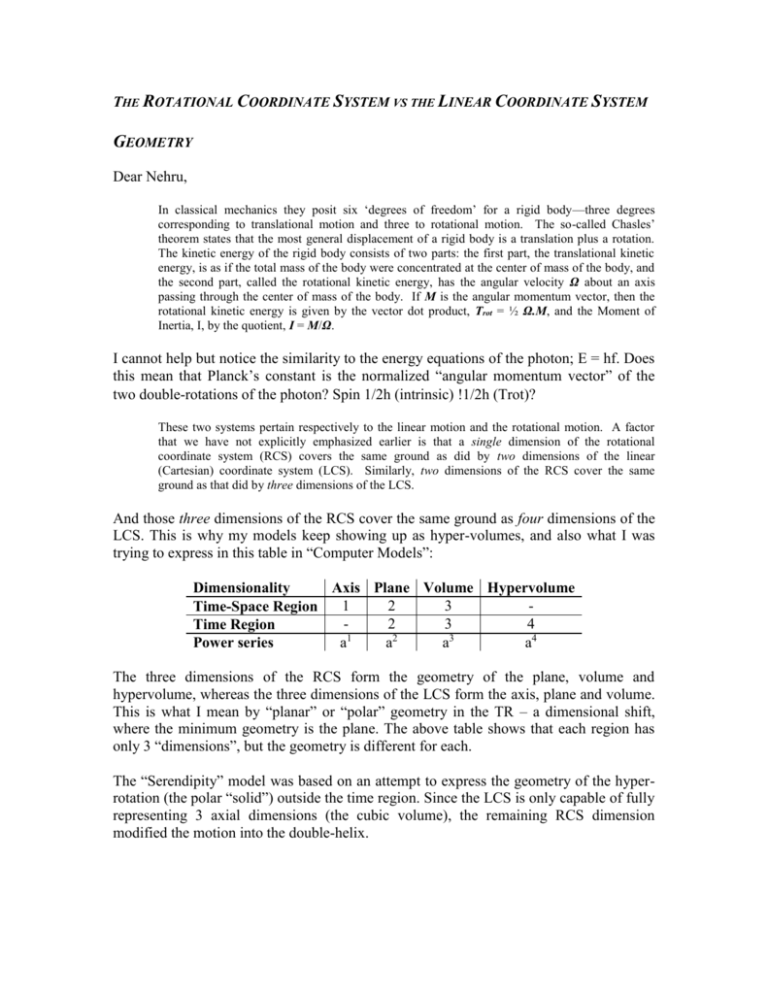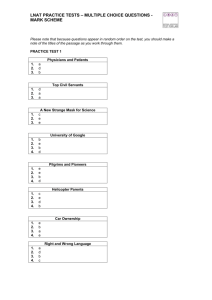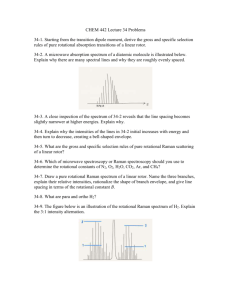Rotational vs Linear Cood Sys BP
advertisement

THE ROTATIONAL COORDINATE SYSTEM VS THE LINEAR COORDINATE SYSTEM GEOMETRY Dear Nehru, In classical mechanics they posit six ‘degrees of freedom’ for a rigid body—three degrees corresponding to translational motion and three to rotational motion. The so-called Chasles’ theorem states that the most general displacement of a rigid body is a translation plus a rotation. The kinetic energy of the rigid body consists of two parts: the first part, the translational kinetic energy, is as if the total mass of the body were concentrated at the center of mass of the body, and the second part, called the rotational kinetic energy, has the angular velocity Ω about an axis passing through the center of mass of the body. If M is the angular momentum vector, then the rotational kinetic energy is given by the vector dot product, Trot = ½ Ω.M, and the Moment of Inertia, I, by the quotient, I = M/Ω. I cannot help but notice the similarity to the energy equations of the photon; E = hf. Does this mean that Planck’s constant is the normalized “angular momentum vector” of the two double-rotations of the photon? Spin 1/2h (intrinsic) 1/2h (Trot)? These two systems pertain respectively to the linear motion and the rotational motion. A factor that we have not explicitly emphasized earlier is that a single dimension of the rotational coordinate system (RCS) covers the same ground as did by two dimensions of the linear (Cartesian) coordinate system (LCS). Similarly, two dimensions of the RCS cover the same ground as that did by three dimensions of the LCS. And those three dimensions of the RCS cover the same ground as four dimensions of the LCS. This is why my models keep showing up as hyper-volumes, and also what I was trying to express in this table in “Computer Models”: Dimensionality Axis Plane Volume Hypervolume 1 2 3 Time-Space Region 2 3 4 Time Region 1 2 3 a a a a4 Power series The three dimensions of the RCS form the geometry of the plane, volume and hypervolume, whereas the three dimensions of the LCS form the axis, plane and volume. This is what I mean by “planar” or “polar” geometry in the TR – a dimensional shift, where the minimum geometry is the plane. The above table shows that each region has only 3 “dimensions”, but the geometry is different for each. The “Serendipity” model was based on an attempt to express the geometry of the hyperrotation (the polar “solid”) outside the time region. Since the LCS is only capable of fully representing 3 axial dimensions (the cubic volume), the remaining RCS dimension modified the motion into the double-helix. Also note that there is a dimensional “inversion” when crossing the unit boundary from the TSR to the TR, so the maximum number of dimensions is the minimum geometric construct: Geometric Relationships Region Type Axial TSR Planar TR # Dimensions 3 3 Minimum 1-Axis 1/4-Hypervolume 2-Plane 1/3-Volume Maximum 3-Volume 1/2-Plane There are some corollaries to the concept of dimensional shifting between regions: 1) The concept of “rotation” in the TR is rotation of a plane about an arbitrary axis, specified by the quaternion (, ix, jy, kz), where is speed of rotation (the cosine of angular speed, as you expressed in “Particle in a Box”), and (x, y, z) represents the normalized vector forming the axis of rotation. With a “unit quaternion”, Q[1,1,1,1], the resultant rotations are depicted by the conic shapes I modeled in “Dimensions.jpg”, when you account for all 4 rotational possibilities (which must occur, since the hyper-volume is the minimum geometry). 2) Because a plane is rotating, it sweeps the LCS equivalent of a volume, hence the minimum rotation in the TR is the “double-rotation.” (In the LCS, you need a line to spin to form a disk, to spin and form the double-rotation volume. In the RCS, you start with an area, and a volume is produced with a single rotation of the plane). Thus, double-rotation is expressed by the turn, rather than the angle. The new insight which made possible this recognition is as follows. Please refer to the Table “Possible Motions in TR and TSRs.” In the case of linear space we assumed—by dint of linguistic habit—that the minimum quantities, 0 in the TR and 1 LNAT in the TSR, always occur. But the actual fact might be that the minimum quantity in the TSR (1 LNAT) and the maximum quantity in the TR (1 LNAT) always occur. Consequently the ground covered by two dimensions of the RCS—for example, as with the spherical coordinates, , and LNAT—would be the same as that covered by three dimensions of the LCS. Brilliant piece of reasoning! That makes total sense. As in the geometric relationships, and inversion would occur for the min/max quantities, as well. What is minimum in the TSR, would be the maximum in the TR: (TSR minimum) = 1/(TR minimum) = TR maximum. This fits in quite well with the quaternion model I am proposing in cor. (1). A quaternion of Q[1,0,0,0] is geometrically impossible, which would be the case if the minimum LNAT occurred (in the TR X,Y and Z planes). With the maximum LNAT, the base construct of the quaternion is Q[1,1,1,1], which results in the generation of the 4 rotational axes depicted in “Dimensions.jpg”. But what about RNAT? The minimum quantity of RNAT in the TR must always occur, and thus the maximum quantity of RNAT must occur in the TSR. And that maximum is a hyper-rotation, not having a direct representation in the TSR. Could this account for the natural occurrence of complex waves that you describe in “Particle in a Box”? With the imaginary part of the wave being the representation of the “4th dimension” of the TR? It would mean that all primary motion in the TSR would have a rotational characteristic in nature, forming spirals rather than lines. Corollaries: 3) Since the geometry of the TR precludes the existence of linear structures, the expression of LNAT must be rotational, as a secondary “single-rotation”, since double-rotation is primary in the TR (cor. 2). (In Projective/Synthetic Geometry, this is called shift). 4) Rotational motion beyond 1 RNAT (maximum) is not possible in the TSR (upper bound of radians). 5) Linear motion beyond 1 LNAT is not possible in the TR (upper bound of 1). 6) The addition of motion to increase an existing motion beyond the maximum will result in: a. Transfer of motion to a dimension that is not yet at the maximum, resulting in dimensional symmetry of motion. b. Reversal of motion back toward the minimum. c. When the minimum is passed, an increase in magnitude of an unbounded motion occurs (scalar reversals and “folds”). This increase is distributed dimensionally, to retain symmetry. Cor. (6) needs some explanation: In the TSR, “rotational motion”, angle, is bounded and linear motion, distance, is unbounded. So when the angle reaches maximum (), the motion reverses back to the minimum (0). The direction is now inward (towards minimum). Once the minimum is reached, the distance is increased, the direction is reversed, and the angle starts again (rotational depth). This rotational depth “distance” appears to be in the imaginary axis, resulting in a whirlpool-like spiral for the rotation. In the TR, “linear motion”, the shift, is bounded, and rotational motion, the turn, is unbounded. So when the shift reaches maximum, and there are no dimensions at minimum, the turn is increased in magnitude. The shift is representative of Larson’s “electric” rotation of atoms (single-rotation, cor. (3)), and the turn is representative of the “magnetic” rotation (double-rotation, cor. (2)). Thus, shift appears to builds turn. On Infinity A thought: are the “infinite” maximums, truly infinite? We see no infinite structures in Nature. Everything has a limited size, and then breaks down. Therefore, the infinite upper limits must be just a potential, not an actuality. We observe that when structures reach the “upper limits” of motion, they either break down (thermal limit, age limit, radioactivity), or disappear into the cosmic sector (quasars, cosmic bubbles). This appears to be related to the total motion exceeding the 2-unit maximum in all scalar dimensions, so that would be the true “maximum” motion of LNAT and RNAT. Corollaries: 7) When the maximum scalar speed is reached, additional motion takes place in a second (or third) scalar dimension. 8) When all three scalar dimensions have reached maximum scalar speed (3), the motion becomes the minimum motion of the conjugate sector. 9) Larson’s “speed ranges” are defined by the number of primary motions that reach maximum speed (2 units). In the TSR, it is 2 * 3 LNAT. In the TR, it is 2 * 4 RNAT. (There are 4 primary rotations defined by quaternions in the TR). Time-Space Region Speed Ranges (maximum volume, 3 axes) Speed Range 0 Unit motion Low 1-x 1 Intermediate 2-x 2 Ultra-High 3-x M/C boundary +1 0 1 1 1 2 2 2 Units of Speed per Dimension 0 0 1 1 1 2 2 0 0 0 1 1 1 2 Time Region Speed Ranges (minimum hypervolume, 4 planes) The Periodic Table Speed Range i1-x i2-x i3-x i4-x -1 Units of Speed per Dimension Atom Time-Space Region Larson 1 2 3 4 Rotational Depth i? A-B-C Scalar Units deuteron (Rot. Base) 0 0 0 0 0 0 1-0-0 1 particle 1 0 0 0 1 2 1-1-0 2 He 1 1 0 0 2 4 2-1-0 3 Ne 1 1 1 0 3 6 2-2-0 4 Ar 1 1 1 1 4 8 3-2-0 5 Kr 2 1 1 1 5 10 3-3-0 6 Xe 2 2 1 1 6 12 4-3-0 7 Rn 2 2 2 1 7 14 4-4-0 8 T/S boundary 2 2 2 2 8 16 5-4-0 9 As we noted already, of the three rotational operators i, j and k, only two are really independent (the third being defined in terms of these two). Now if our dimensional constraint equation, n(n1)/2 = n, holds good whether applied to the LCS or to the RCS, the number of independent rotational coordinates in the TR has to be 3. That is to say, three independent rotational coordinates have to exist in this Region. (Kindly see the communication ‘Time Region Speeds–8’ wherein we explained them to be i, j and l.) Further we can see that the ground covered by these three independent rotational coordinates would be tantamount to the ground covered by FOUR dimensions of the linear coordinate system. I suppose that this is exactly what you were endeavoring to bring out in your communication ‘Regional Dimensionality’ when you say “This makes the TR 4-dimensional in interaction, though only requiring 3 values to represent it…” Yes, that was the idea I was trying to relate. Here is something else to consider: I have done an analysis on quaternions and their intrinsic geometry. When a quaternion is converted to homogeneous coordinates for manipulation, something interesting shows up. The i and j operators do not translate to simple rotation, but to complex waveforms, exactly as you describe in “Particle in a Box.” The interesting transformation, however, is the k operator. Being the product of i.j, it has a real transform, equal to ±1, and the k operator appears as a bi-vector… BUT, it is not a translational vector, but a shear vector! In other words, it represents the strain between the two planar rotations formed by the i and j operators. Now if we consider the “magnetic” double-rotations represented by the i and j operators to be temporal displacements (imaginary), then the k operator, their product, is real, and would appear as a spatial displacement of a secondary, single-rotation (“LNAT” motion, per cor. (3)) – the electric displacement of atoms! Because the k operator is “±”, the electric displacement will have both a positive and negative valence associated with it. When the two magnetic rotations are parallel, the strain is zero – and you have the noble gases. The maximum strain occurs when they are anti-parallel, and gives the midpoint elements, such as carbon and silicon. This means that the “electric rotation” isn’t a “rotation” at all, but a quantized representation of strain between two magnetic rotations of dissimilar turn or orientation. I still have to work out the mathematical details and build a computer simulation, but it is looking very good. Bruce







